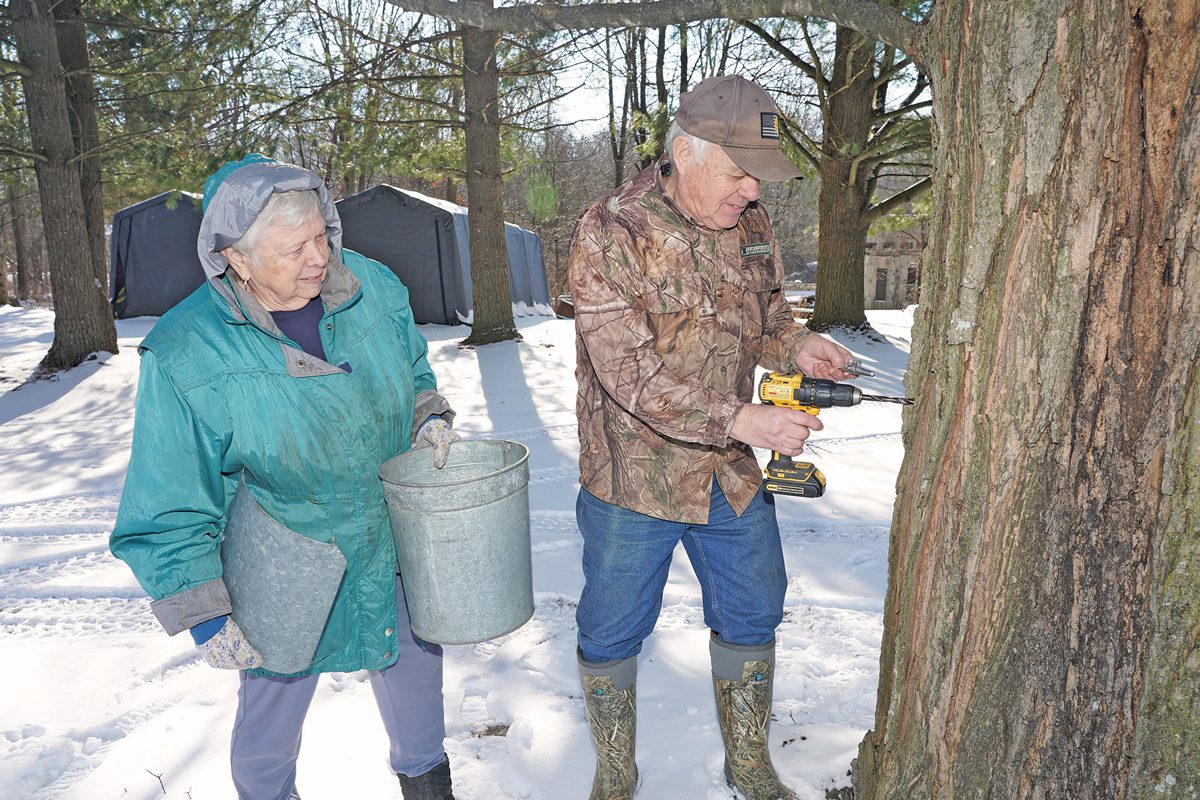
For Elsi and Bob Sly, tapping trees to make maple syrup is a family tradition. It takes forty gallons of sap to make one gallon of syrup, and three weeks of hard work can yield anywhere from one to twelve gallons. | Photo by Mark Bialek
After dusk on a cold, starry night, guests can easily follow the enticing aromas of a wood fire and a sweet treat across patches of snow to Elsi and Bob Sly’s sugar shanty. Open the door, and a fog of evaporating sap and an array of hot dogs, baked beans, and salads promise a one-of-a-kind winter picnic.
“We make maple syrup the traditional way,” Elsi says firmly. “We want our grandchildren and great-grandchildren to understand how their family made maple syrup in the old days and ways.”
The season for maple syrup–making has begun here in Michigan, and the Slys are continuing a family tradition that dates back to the days when their relatives were among the state’s earliest settlers.
Bob grew up on a farm in Vantown, where seven generations of Slys farmed 480 acres. They started making maple syrup during World War II, when the government rationed sugar. Elsi was raised on a 160-acre dairy farm outside Cedar Springs that relied on the sap from 500 sugar maple trees to supplement their income.
Forty years ago, the Slys built a gambrel-roofed house and pole barn on ten and a half acres at the end of a long and winding road west of Ann Arbor. A carved sign announces “Hickory Lea,” named for the huge hickory tree that stands in the midst of rolling fields. They were equally delighted that the property had fifty maple trees.
In one of Elsi’s happiest childhood memories, she and other family members are riding on the back of a tractor, watching the big wheels lurch over the mud holes. When her father put on the brakes, everyone jumped out, grabbed empty buckets, and traded them for the sap-filled ones hanging on the trees. They dumped the sap into the trailer’s 200-gallon vat and continued on the way to the next trees.
When the Slys’ children were young, the family traveled back and forth from Ann Arbor to the Elsi family’s centennial farm, to help collect, boil, feed the fires, bottle, and label the maple syrup. “It was very important to us that our kids participated in the family traditions,” Elsi says.
The syrup season is short—only two to four weeks—but intensive. Sap starts running when daytime temperatures reach forty degrees and evening temperatures are below freezing.
“Dad—and the rest of us—worked day and night during those weeks, collecting and boiling the sap,” Elsi recalls. “Like us, he only used firewood that he cut on the farm—and the boiling process requires a lot of wood.” And sleepless nights.
Her father fed the fires until nine or ten o’clock at night, when her mother replaced him so he could catch a few hours of sleep. He returned to the sugar house at two o’clock in the morning, so his wife could rest. When she returned long before the sunrise, he went off to tend to their dairy herd.
When her parents passed away, Bob decided to build their own sugar shanty (“not a shack!”), a cozy cabin barely in sight of the large kitchen windows.
As daytime winter temperatures begin to warm, Bob takes his antique brace-and-bit (if grandchildren or guests are present) or an electric drill (for efficiency) to bore as many as five holes in the trunks of the sugar maple trees scattered throughout the property, as well as several additional maples on his neighbors’ lands. For maximum sap, the best place to drill is on the trees’ sunny side, above a thick root or below a large branch.
Then he inserts spiles—a type of spigot—into the holes, hangs his buckets, and waits. For how long, no one really knows; that’s Mother Nature’s mystery. Bob checks the trees daily, and when the buckets begin to fill, he drives a Kawasaki Mule utility vehicle from tree to tree to collect the sap and bring it to the shanty.
Related: Dixboro Pure
The Slys use an antique cream separator, tapered, with a valve at the bottom, to filter the sap three times, removing bugs, twigs, wood chips, and other debris. Then they pour the sap into a twelve-by-fourteen-foot evaporator over an enclosed wood fire. Forty gallons of sap produce just one gallon of syrup
Producing ten gallons takes about three cords of wood, and during their best year, the Slys made twelve gallons. One year, they only made one gallon. But the average is eight or nine—“enough for our family’s use and gifts,” Elsi says.
“The early sap is the best—light-colored, with high sugar content,” she says. “The later sap is darker. The golden bubbles are beautiful when the syrup is almost ready—and the aroma is out of this world.”
“It’s a hard two or three weeks, but it’s very satisfying,” Bob says. “We make it fun by roasting hot dogs in the sugar shanty and inviting friends and grandchildren to join us.”
“We do this for the old-fashioned feel and the satisfaction of knowing we appreciate what nature offers us,” says Elsi. “It’s very important to us that our grandkids know the old ways.”
They have a motto, she adds with a smile: “Life is too short for fake maple syrup!”